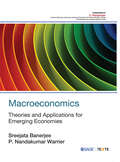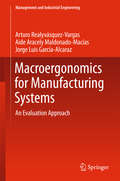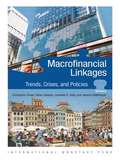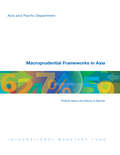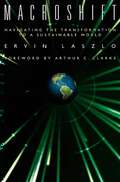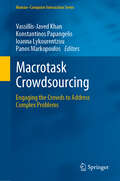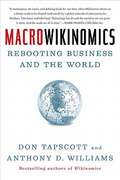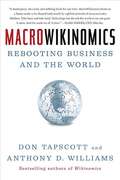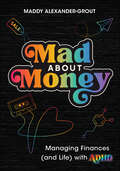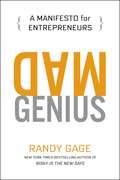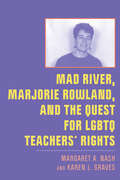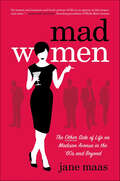- Table View
- List View
Macroeconomics: Theories and Applications for Emerging Economies
by Sreejata Banerjee P. Nandakumar WarrierA comprehensive text on macroeconomic theories with reference to developing economies. This new textbook presents macroeconomic theory and its implications in policy formulation in a unique manner, continuously weaving in scenarios from India and other emerging economies. While the book meticulously guides the reader through the workings of key macroeconomic models, it also discusses at length the assumptions that make the models applicable to developing market nations. It offers interesting insights into the Simple Keynesian Cross Model, international capital movement and different schools of macroeconomic thought, and compares macroeconomic models of developed and developing economies. Key Features: Boxed text highlighting experiences of emerging market economies and demonstrating the role of macroeconomic theory in policy implications Use of charts and tables with current data for better comprehension and illustration of the theories and inter-linkages of macroeconomic forces Theoretical content of each chapter is illustrated and supplemented by relatable examples and case studies based on policies undertaken by the Indian economy A must-have companion for students of economics, policy studies, management, administrative services, commerce and others
Macroeconomics: Theory Through Applications
by Russell Cooper A. Andrew JohnThis textbook, Macroeconomics: Theory Through Applications, centers around student needs and expectations through two premises: ... Students are motivated to study economics if they see that it relates to their own lives. ... Students learn best from an inductive approach, in which they are first confronted with a problem, and then led through the process of solving that problem. Many books claim to present economics in a way that is digestible for students; Russell and Andrew have truly created one from scratch. This textbook will assist you in increasing students' economic literacy both by developing their aptitude for economic thinking and by presenting key insights about economics that every educated individual should know.
Macroeconomía argentina: Manual para (tratar de) comprender el país
by Lucas Llach Miguel BraunBraun y Llach presentan de modo simple, consistente y realista las nociones básicas de la macroeconomía y las aplican de manera aguda y original a las peculiaridades del caso argentino. Pensado y escrito desde la perspectiva de nuestra economía, este libro es no sólo un manual completo sobre los conceptos fundamentales de la macroeconomía, sino también una caja de herramientas accesible y eficaz para entender los debates actuales sobre la realidad argentina. ¿Por qué algunos países son ricos y otros pobres? ¿Qué factores determinan el crecimiento económico? ¿Cómo inciden las políticas públicas en los niveles de producción, empleo y precios? ¿Cuáles son las causas de la inestabilidad argentina? ¿Qué papel juega la globalización en una economía como la nuestra? ¿De qué dependen los movimientos de los precios o del tipo de cambio? ¿De qué hablamos cuando hablamos de inflación o déficit fiscal?
Macroergonomics for Manufacturing Systems
by Jorge Luis García-Alcaraz Arturo Realyvásquez Vargas Aide Aracely Maldonado-MaciasThis book introduces the main concepts of manufacturing systems and presents several evaluation approaches for these systems' evaluation. The relevant macroergonomics methods are summarized and the theoretical framework for Macroergonomic Compatibility construct is explained. This book presents a Macroergonomic Compatibility Model which proposes an instrument in the form of a Macroergonomic. The authors introduce a methodology to obtain a novel Macroergonomic Compatibility Index that enables manufacturing companies to assess and follow their progress on the implementation of macroergonomics practices.
Macrofinancial Linkages: Trends, Crises, and Policies
by Simon Johnson Jonathan D. Ostry Christopher Crowe Jeromin ZettelmeyerA report from the International Monetary Fund.
Macrologistics Management: A Catalyst for Organizational Change (Resource Management Ser.)
by Frank Voehl Martin SteinMacrologistics Management defines the term "Macrologistics" as a means for designing a catalyst for change in any organization. The "macro" approach means seeing the big picture-to use time and place strategies for competitive advantage. It is a "breakthrough" strategy because it prioritizes "logistics" selection as a key factor in developing customer satisfaction and market penetration. Traditional management approaches the product and cost savings as key factors in their strategy. This book demonstrates how new approaches can be even more effective and more profitable-it will help you achieve complete transformation in your organization through a systematic process for managing change and by using carefully prioritized change management strategies. The framework for change, as explained in this book, is one where continuous monitoring is facilitated by a relevant and responsive information system, workers and managers are empowered and rewarded for innovation, and leaders encourage a passion for change. With Macrologistics Management you will learn how to unleash new sources of synergy-ways for various groups involved with the organization to work together-that help promote creativity and motivate an effective and rapid revolution in your workplace!
Macroprudential Banking Supervision & Monetary Policy: Legal Interaction In The European Union
by Luca AmorelloThe European experience suggests that the efforts made to achieve an efficient trade-off between monetary policy and prudential supervision ultimately failed. The severity of the global crisis have pushed central banks to explore innovative tools—within or beyond their statutory constraints—capable of restoring the smooth functioning of the financial cycle, including setting macroprudential policy instruments in the regulatory toolkit. But macroprudential and monetary policies, by sharing multiple transmission channels, may interact—and conflict—with each other. Such conflicts may represent not only an economic challenge in the pursuit of price and financial stability, but also a legal uncertainty characterizing the regulatory developments of the EU macroprudential and monetary frameworks. In analyzing the “legal interaction” between the two frameworks in the EU, this book seeks to provide evidence of the inconsistencies associated with the structural separation of macroprudential and monetary frameworks, shedding light upon the legal instruments that could reconcile any potential policy inconsistency.
Macroprudential Frameworks in Asia
by Rodolfo Maino Steven A. BarnettA report from the International Monetary Fund.
Macroprudential Indicators of Financial System Soundness
by Delisle Worrell Owen Evans Mark O'Brien Jun Nagayasu Paul Hilbers Alfredo M. Leone Mahinder Gill Winfrid Blaschke Russell Krueger Marina Moretti Joy Ten BergeThis paper aims to take stock of current knowledge in the area of MPIs - macroprudential indicators. MPIs are defined broadly as indicators of the health and stability of financial systems. The paper also looks at issues related to the use of MPIs in IMF surveillance, and their dissemination either through the IMF Special Data Dissemination Standard (SDDS), or in other ways. In particular, the paper looks at: the MPIs that could be used most effectively by the IMF in its surveillance work; the modalities and options for the compilation of such data; and the possible dissemination of MPIs to the public. Initiatives taken by the IMF includes the issue in 1998 , of an internal guidance note designed to facilitate discussions in the context of article IV of the IMF charter. It suggests specific areas for discussion including: sectoral indicators; macroeconomic factors that impact the financial system; elements for the assessment of the institutional and regulatory frameworks; and the main effects of financial system distress. The paper has benefitted from feedback from a consultative meeting held in 1999 to discuss experiences of member countries and the international community.
Macroprudential Policy
by Richard BarwellThis book reviews the key policy debates during the post-crash era, describing the issues that policymakers grappled with, the decisions that they took and the details of the policy instruments that were created. It focuses specifically on the policy regimes at the epicentre of the crisis: micro- and macro-prudential policy with chapters exploring the revolution in the conduct of macroeconomic policy in the period since the financial crisis. The author shows that throughout this period policymakers have had to balance two conflicting objectives - to repair balance sheets in the banking and public sectors whilst simultaneously trying to catalyse an economic recovery - and that has required them to innovate new tools and even new policy regimes in response. This book goes behind the jargon and explains what exactly policymakers at the Bank of England, the Treasury and beyond did and why, from QE to austerity to Basel III.
Macroprudential Policy and Practice (Macroeconomic Policy Making)
by Paul Mizen Margarita Rubio Philip TurnerMacroprudential policy is perhaps the most important new development in central bank policymaking circles since the global financial crisis, and reliance on such policies has continued to spread. The crisis, which showed the limits of conventional monetary policy as a tool to deal with financial stability, forced a wide-ranging rethink of economic policies, their interactions and their repercussions. It has led to new forms of intervention, of regulation and of supervisory practice. Macroprudential regulation is now one of the most important topics in modern macroeconomics, because it concerns measures put in place to reduce the risks and costs of the instability caused by financial crises. Written by senior figures from the worlds of academia and banking, this volume combines theoretical approaches with hard evidence of the policy's achievements in many countries. It is the first in-depth analysis of macroprudential instruments for policymakers, banks and economists.
Macroprudential Regulation and Policy for the Islamic Financial Industry
by Muhamed Zulkhibri Abdul Ghafar Ismail Sutan Emir HidayatThis volume aims to discuss thecurrent research, theory, methodology and applications of macropreudentialregulation and policy for the Islamic financial industry. Published incooperation with the Islamic Research and Training Institute (IRTI), this book featurescontributions from a workshop presented in collaboration with the UniversityCollege of Bahrain (UCB) in Manama, Bahrain, aimed to bring together experts inIslamic banking and regulation and financial economics. This resulting booksheds light on how macroprudential policy may be implemented in the Islamicfinancial system, and indicates current challenges and their effects oneconomic growth, financial stability and monetary regulation. Macroprudential policyis increasingly seen as a way of dealing with the different dimensions ofsystemic risk. But many central banks, bank supervisors and regulators havelimited experience with macroprudential tools, particularly in the Islamicfinancial industry. Given the complementarities between monetary policy andfinancial stability, it appears that central banks would always play animportant role in macroprudential policy. But how should macroprudential policybest interact with monetary policy? It is becoming more pressing for the centralbanks to conduct monetary policy in which its conventional banking systemoperates side by side with Islamic banking system. This question has receivedincreasing attention in the research literature but there is much we still needto learn. This is why new insights from research on macroprudential policy -which has gained important impetus in recent years - are so valuable. Featuringcontributions on topics such as macroprudential regulation, policy, tools andinstruments; governance, systematic risk, monetary policy, and bank leverage,the editors provide a collection of comprehensive research covering the mostimportant issues on macroprudential policy and regulation for the Islamicfinancial industry. This volume is expected to be a significant contribution tothe literature in the field of Islamic finance and evaluation of publicpolicies to promote the development for Islamic financial industry. It is alsoserved as a key text for students, academics, researchers, policy-makers in thefield of Islamic finance.
Macroprudential Supervision In Insurance
by Jan Monkiewicz Marian MałeckiMacroprudential policies, tools and supervision have become the most important regulatory and supervisory innovation across the globe in recent years. This very relevant topic, which became important after the last financial crisis, is the subject matter of numerous studies and policy papers. Most contributions to the field however are banking-oriented and rarely address other segments of the financial sector. It seems only natural therefore that a more balanced approach is required. Macroprudential Supervision in Insurance fills this existing vacuum and advances our understanding of macroprudential oversight in insurance. The book is split into three parts. The first part addresses general and methodological issues and provides a framework for the analysis of macroprudential policies and supervision in the insurance context. The second part focuses on policy related issues: balance between macro and micro, the macroprudential supervisory toolkit, GSII related aspects and the institutional dimension of macroprudential supervision. The third part focuses on global level aspects of macroprudential in insurance, making this an ideal resource for the supervisory community, the insurance industry and anyone interested in insurance regulation.
Macroshift: Navigating the Transformation to a Sustainable World
by Ervin LaszloWe live in the midst of one of the greatest technological revolutions in history, an era of deep-seated transformation-a macroshift in civilization, says preeminent scholar and futurist Ervin Laszlo. Its signs and manifestations are all around us, from the deadly HIV/AIDS epidemic sweeping Africa and the dangerous fire-trap sweatshops routinely killing workers in Bangladesh, to the environmental havoc created by genetic engineering, power plant pollution and mechanized agriculture. The application of new technologies has turned into a double-edged sword. The world is growing together in some respects, but is coming apart in others. Worldwide economic globalization, another sign of the macroshift, all too often benefits the few rather than the many. Hundreds of millions live at a higher material standard of living, but thousands of millions are pressed into abject poverty. The richest 20% earn ninety times the income of the poorest 20%, consume eleven times as much energy, and eat eleven times as much meat. There have been other macroshifts in human history, but they spanned centuries, allowing cultural values, beliefs, and change to occur gradually. Today, technology has reduced our time to adapt; the entire critical period of change is compressed into the lifetime of a generation. Today's macroshift, explains Laszlo, harbors great promise, as well as grave danger. He outlines two possible scenarios: "The Breakdown," where we choose to drift without a change in our current direction toward chaos, anarchy, and destruction, or "The Breakthrough," where we collectively transform our thinking and behavior to produce creative, sustainable solutions to dangerous global problems. And he shows what each of us can do-politically, professionally, and privately-to bring about the Breakthrough and shape a humane and sustainable global future. While technology is what drives the unprecedented speed of this macroshift, it is our vision, values, and actions now that will ultimately determine the outcome. The choice is up to us-the power is in our hands.
Macrotask Crowdsourcing: Engaging the Crowds to Address Complex Problems (Human–Computer Interaction Series)
by Panos Markopoulos Vassillis-Javed Khan Konstantinos Papangelis Ioanna LykourentzouCrowdsourcing is an emerging paradigm that promises to transform several domains: creative work, business work, cultural cooperation, etc. Crowdsourcing reflects the close-knit interplay between the latest computer technologies, the rapidly changing work model of the 21st century, and the very nature of people. The interplay makes for an exciting but at the same time challenging new field to investigate under the lens of a diverse set of disciplines, ranging from the technical to the social and from the theoretical to the applied. Early research has focused on an aspect of crowdsourcing known as micro-tasking. Micro-tasks are simple tasks (like image annotations) that anyone could perform. An emerging area is how to utilize crowdsourcing to solve problems that go beyond simple tasks towards more complex ones, that require collaboration and creativity. In juxtaposition to micro-task crowdsourcing, this book investigates macro-task crowdsourcing and its potential.
Macrowikinomics: New Solutions for a Connected Planet
by Don Tapscott Anthony D. WilliamsIn their bestseller Wikinomics, Don Tapscott and Anthony Williams showed the world how mass collaboration was changing the way businesses communicate, create value, and compete in the new global marketplace. This sequel shows that in more than a dozen fields-from finance to health care, science to education, the media to the environment-we have reached a historic turning point. Collaborative innovation is revolutionizing not only the way we work, but how we live, learn, create, govern, and care for one another. The wiki revolutions of the Arab Spring were only one example of how rebuilding civilization was not only possible but necessary. With vivid examples from diverse sectors, Macrowikinomics is a handbook for people everywhere seeking a transformation of industry and institutions by embracing a new set of guiding principles, including openness and interdependence. Tapscott and Williams argue that this new communications medium, like the printing press before it, is enabling nothing less than the birth of a new civilization. .
Macrowikinomics: Rebooting Business and the World
by Don Tapscott Anthony D. WilliamsIn their 2007 bestseller, Wikinomics Don Tapscott and Anthony Williams showed the world how mass collaboration was changing the way businesses communicate, create value, and compete in the new global marketplace. Now, in the wake of the global financial crisis, the principles of wikinomics have become more powerful than ever. Many of the institutions that have served us well for decades or centuries seem stuck in the past and unable to move forward. And yet, in every corner of the globe, a powerful new model of economic and social innovation is sweeping across all sectors--one where people with drive, passion, and expertise take advantage of new Web-based tools to get more involved in making the world more prosperous, just, and sustainable.
Macy's: Evolution in the Sunshine State
by Boris Groysberg Das Narayandas Sarah L. Abbott Benson P. ShapiroIn 2009, Lee O'Rourke was promoted to District Vice President in charge of Macy's newly created North Florida district. This district consisted of 11 stores located in the greater Orlando area and in the east coast towns of Daytona, Melbourne, Merritt Island, and Vero Beach. The performance of these stores had lagged in recent years, and O'Rourke was charged with building a cross-functional district team to support these stores and with improving their overall performance.
Mad About Money: Managing Finances (and Life) with ADHD
by Maddy Alexander-GroutMad About Money will help you to make sense of your life if you are neurodivergent or suspect you might be. Maddy, a 40 year old mum of two, has had her fair share of struggles with money, life and business without always understanding why. With her ADHD and Autism diagnosis, everything suddenly made more sense, and she has used her diagnosis to improve her life. Mad About Money: Managing finances (and life) with ADHD is not your typical money book, it is an unfiltered, honest, sweary and inspiring journey through the life of an undiagnosed neurodivergent woman. Award-winning writer and CPD-accredited neurodiversity specialist , money and business coach Maddy Alexander-Grout walks you through the story of her life. By sharing her own difficulties with money, spending, and debt, she shows you how to apply the lessons she learned in climbing back from over £40000 in consumer debt. But this book is not just about money, it's about the struggles she has had along the way as an undiagnosed neurodivergent with ADHD, Autism, Dyspraxia and more. This book will give you actionable tips to navigate life as a neurodivergent, manage your money, learn to understand your brain and make sense of your past, especially if you are, or suspect you, are neurodivergent. In the book: Applicable strategies for managing your money, parenting , mental health and starting a business as an undiagnosed neurodivergent Tips for managing your ADHD and other neurodivergent conditions Strategies for how to deal with a range of financial challenges—including debt and spending addictions—when you're neurodivergent An essential read for anyone who is neurodivergent or suspects they might be, especially if they have struggled with money and life up to now. Mad About Money is empowering, insightful and the perfect read for anyone who feels misunderstood in a world designed for neurotypical people.
Mad Genius
by Randy GageThis is a manifesto about ideas. Big ideas, small ideas, and outlandish ideas. Ideas that innovate, ideas that disrupt markets, and especially ideas that irritate. More than ideas, though, Mad Genius is about how ideas are born and the role they play in entrepreneurial thinking.This is a manifesto for managers who want to become leaders and leaders, who want to blow up mediocrity. Because whether you work in a traditional business, a nonprofit service organization, or in the public sector, the best way to create fresh and innovative solutions is to think like an entrepreneur.From the Hardcover edition.
Mad River, Marjorie Rowland, and the Quest for LGBTQ Teachers’ Rights (New Directions in the History of Education)
by Margaret A. Nash Karen L. GravesMad River, Marjorie Rowland, and the Quest for LGBTQ Teachers’ Rights addresses an important legal case that set the stage for today’s LGBTQ civil rights–a case that almost no one has heard of. Marjorie Rowland v. Mad River School District involves an Ohio guidance counselor fired in 1974 for being bisexual. Rowland’s case made it to the U.S. Supreme Court, but the justices declined to consider it. In a spectacular published dissent, Justice Brennan laid out arguments for why the First and Fourteenth Amendments apply to bisexuals, gays, and lesbians. That dissent has been the foundation for LGBTQ civil rights advances since. In the first in-depth treatment of this foundational legal case, authors Margaret A. Nash and Karen L. Graves tell the story of that case and of Marjorie Rowland, the pioneer who fought for employment rights for LGBTQ educators and who paid a heavy price for that fight. It brings the story of LGBTQ educators’ rights to the present, including commentary on Bostock v Clayton County, the 2020 Supreme Court case that struck down employment discrimination against LGBT workers.
Mad Scenes and Exit Arias: The Death of the New York City Opera and the Future of Opera in America
by Heidi WalesonFrom the Wall Street Journal’s opera critic, a history of how and why the New York City Opera went bankrupt—and what it means for the future of the arts.In October 2013, the arts world was rocked by the news that the New York City Opera—“the people’s opera”—had finally succumbed to financial hardship after 70 years in operation. The company had been a fixture on the national opera scene—as the populist antithesis of the grand Metropolitan Opera, a nurturing home for young American talent, and a place where new, lively ideas shook up a venerable art form. But NYCO’s demise represented more than the loss of a cherished organization: it was a harbinger of massive upheaval in the performing arts—and a warning about how cultural institutions would need to change in order to survive.Drawing on extensive research and reporting, Heidi Waleson, one of the foremost American opera critics, recounts the history of this scrappy company and reveals how, from the beginning, it precariously balanced an ambitious artistic program on fragile financial supports. Waleson also looks forward and considers some better-managed, more visionary opera companies that have taken City Opera’s lessons to heart.Above all, Mad Scenes and Exit Arias is a story of money, ego, changes in institutional identity, competing forces of populism and elitism, and the ongoing debate about the role of the arts in society. It serves as a detailed case study not only for an American arts organization, but also for the sustainability and management of nonprofit organizations across the country.“An intricate whodunit that seeks to find out who murdered the New York City Opera. . . . Waleson gives us a vivid description of each death-defying crisis and a sharp portrait of the ever-changing cast of would-be saviors who somehow always failed in their mission.” —The New York Times Book Review“Thoroughly researched, factually detailed, judgmentally well-balanced, and engrossing.” —Opera“Waleson’s in-depth study illustrates the challenges City Opera—and other opera houses—face in the 21st century as they seek to preserve tradition and innovate.” —Publishers Weekly“A thorough recounting of the tumultuous history of the New York City Opera [and] a cleareyed examination of the economic fragility of cultural institutions.” —Kirkus Reviews
Mad Science: The Nuclear Power Experiment
by Joseph ManganoWill Americans once again play nuclear roulette? Just one year after the Fukushima meltdown, all 54 reactors in Japan have been closed, and may never be restarted. Germany recently closed several reactors, and will shutter them all within a decade. Italy revoked its pledge to build new reactors, keeping that nation nuclear-free. All these decisions are based on the understanding that reactors are extremely dangerous and expensive. In the U. S. , the remnants of the once-overwhelmingly powerful nuclear lobby are making their last stand for "clean" nuclear energy. The sixty-year-old vision of power "too cheap to meter" (words originally uttered by a banker promoting the industry), is back. While other countries end their reliance on nuclear energy, Americans contemplate its revival, even as existing American reactors, which produce a fifth of U. S. electricity, pass retirement age and are corroding. In Mad Science, Joseph Mangano strips away the near-smothering layers of distortions and outright lies that permeate the massive propaganda campaigns on behalf of nuclear energy. He explores the history of the industry, with its origins in the Manhattan Project, through its heightening promotion during the Cold War and its entwinement with nuclear weapons. Mad Science includes an account of nuclear accidents and meltdowns and their consequences, from Chernobyl to Santa Susana and beyond; as well as a point-by-point refutation of pro-nuke arguments. Atomic energy is unsafe - it deals with staggeringly poisonous substances at every stage of its creation - un-economical in the extreme and impractical.
Mad Women
by Jane MaasPrimero el trabajo, luego el marido y después los niños: esas eran las reglas de Jane Maas cuando trabajaba como redactora en una agencia de Madison Avenue en los años sesenta, una época en que las mujeres con hijos eran franca minoría en estos cargos. Abrirse camino en una jungla poblada de caballeros con corbata no fue fácil para la joven Jane: las pocas mujeres publicistas se hacían cargo solo de cuentas pequeñas, percibían salarios menores, estaban sujetas a sufrir acoso sexual y no contaban con herramientas para defenderse más allá de su astucia y voluntad de triunfar.En Madison Avenue la creatividad, el sexo, el alcohol, el tabaco y las fiestas estaban a la orden del día, y Jane Maas evoca, con más humor que nostalgia esos días en que no existían los ordenadores, Internet y la telefonía móvil, cuando el papel carbón campaba a sus anchas y una señorita tenía que llevar guantes y saber sentarse en el taburete de un bar si quería conquistar el mundo.A través de anécdotas insólitas y divertidos chismorreos, Maas recorre su trayectoria profesional y revela cuánto hay de cierto -y de incierto- en la famosa serie de televisión Mad Men.¿Alguien quiere imaginarse paseando por las calles de Manhattan y trabajando al lado de Don Draper? Mad Women es su libro.«Devoré Mad Women de un bocado... y fue delicioso.»Jane Fonda
Mad Women: The Other Side of Life on Madison Avenue in the '60s and Beyond
by Jane MaasA New York copywriter reveals what it was like to be a woman in the 1960s male-dominated advertising world depicted in the hit show Mad Men.What was it like to be an advertising woman on Madison Avenue in the ‘60s and ‘70s—that Mad Men era of casual sex and professional serfdom? A real-life Peggy Olson reveals it all in this immensely entertaining and bittersweet memoir.Fans of the show are dying to know how accurate it is: was there really that much sex at the office? Were there really three-martini lunches? Were women really second-class citizens? Jane Maas says the answer to all three questions is unequivocally “yes.” Her book, based on her own experiences and on countless interviews with her peers, gives the full stories, from the junior account man whose wife almost left him when she found the copy of Screw magazine he’d used to find “a date” for a client, to the Ogilvy & Mather’s annual Boat Ride, a sex-and-booze filled orgy, from which it was said no virgin ever returned intact. Wickedly funny and full of juicy inside information, Mad Women also tackles some of the tougher issues of the era, such as unequal pay, rampant, jaw-dropping sexism, and the difficult choice many women faced between motherhood and their careers.
